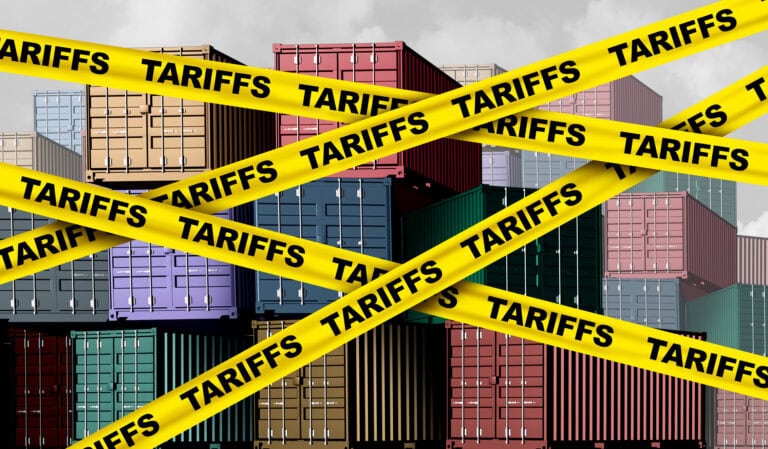AI in Supply Chains: Navigate Tariff Uncertainty Smarter


Manufacturing businesses across the global supply chain have been rocked again. This time, it’s not a container ship blocking the Suez Canal, a global pandemic or the inability to source ‘the golden screw’. Instead, it’s a result of geopolitical tensions, resulting in a new wave of reciprocal tariffs forcing every supply chain executive to search for forward-looking solutions.
While there is much to think about stemming from the past two weeks, I’m witnessing a very familiar pattern. Just this week, three different manufacturing and distribution executives asked me nearly identical questions:
“Paul, how do we manage skyrocketing costs without gutting our margins?” “What’s our real exposure level across our supplier network? And should we rethink our global component sourcing strategy again?
Let’s face it: traditional supply chain approaches aren’t built for this new reality of perpetual geopolitical disruption, just as they were unprepared for the 2020 pandemic.
AI: Not Just Hype, But A Tariff Survival Essential
While many continue debating whether AI belongs in their tech stack, forward-thinking executives are already deploying it as their secret weapon against tariff chaos. This isn’t surprising. Deloitte’s latest C-suite survey reveals 78% of leaders plan to increase AI investments over the next year.
Why? Because AI-powered supply chain solutions deliver precisely what businesses need in turbulent environments:
AI can help businesses anticipate changes in supply chain necessities by identifying real-time demand needs and over 3, 6, and 12-month timeframes. AI can show managers the differences between repair and replacement costs for critical items. In a chip (ie. nutshell), AI can help your business navigate the tariff uncertainty to plan smarter and buy more accurately. Additionally, new systems can work with existing systems of record a company has had for a decade or more, because it’s not about replacing supply chain software or going through the lengthy process of data cleansing; it is about augmenting the data a business already has with AI-driven intelligence and insights. In short, this is one of the most innovative approaches possible when higher costs could stress revenues.
Scenario modeling at unprecedented speed. Instead of weeks of analysis, AI can help show you the ripple effects of shifting sourcing from China to domestic supply or calculating the true landed cost impact of a 25% tariff on critical components.
Hidden inventory discovery. I’ve yet to meet a single large manufacturer that doesn’t have millions in unaccounted inventory sitting somewhere in their network. AI can uncover these domestic stockpiles, often eliminating the need for tariff-impacted international orders.
Predictive risk mitigation. The best AI platforms also don’t just tell you what’s happening now; rather, they forecast supply chain vulnerabilities months before they materialize, giving you precious time to secure alternatives.
Beyond Tariff Navigation: AI as Competitive Advantage
The real power of AI isn’t just surviving the current tariff storm; it means building a more resilient and agile supply chain for the future. One that outperforms competitors regardless of fleeting market conditions in any single year.
To address inefficiencies and overspend on critical materials, the most effective AI implementations I’ve witnessed deliver three critical capabilities:
Dynamic demand forecasting that works. Forget those static forecasts that were obsolete before they were published. Today’s AI analyzes thousands of variables to provide continuously updated probability forecasts.
Intelligent inventory optimization. AI algorithms can reduce inventory costs by 15-30% while simultaneously improving fill rates. This represents a seemingly impossible balance that becomes achievable when machines can process millions of data points to find the optimal stocking strategy.
Autonomous decision orchestration. The supply chains that will thrive aren’t just using AI for insights—they’re letting AI make routine decisions automatically, freeing human talent to focus on strategic initiatives. They are also using XAI or explainable AI to provide greater transparency into the recommendations AI is providing (more to come on this later!).
The Urgency of Action
Here’s the uncomfortable truth: While you’re considering your new AI strategy, your competitors are more than likely already implementing their systems. The tariff environment will remain unpredictable, and the advantage will go to those who can adapt quickly. Supply chain pros must see the forest through the trees to move from reactive to responsive.
Ask yourself: Can your current software systems instantly identify every product in your portfolio that will be impacted by the new tariffs? Can they automatically recommend alternative sourcing options? Can they simulate the P&L impact of different pricing strategies to offset tariff costs?
If not, you’re fighting tomorrow’s battle with yesterday’s weapons.
The good news? You don’t need to boil the ocean. Start with targeted AI applications focused on your highest-value, most tariff-exposed product lines. The ROI is typically measured in weeks, not years.
The global tariff landscape may be beyond your control, but your response to it isn’t. The supply chain leaders who emerge strongest will be those who leverage AI not just as a technology initiative but as their core strategic advantage in navigating these turbulent times.
Paul Noble,
Founder & CSO of Verusen
